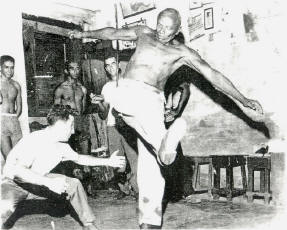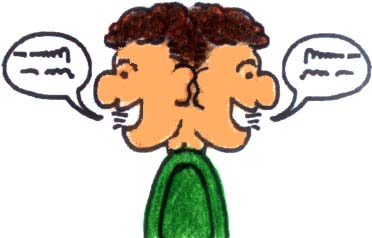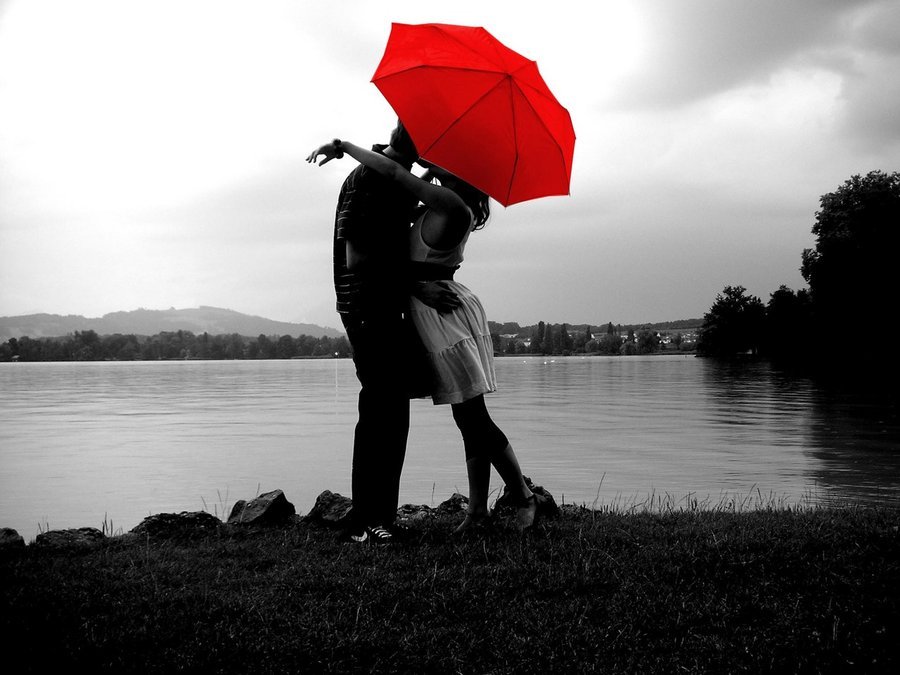
I’ve been making a list of the “key words” that Mestre Valmir and his students emphasize with frequency in the trainings. Here they are, as well as an explanation of more or less what they mean:
Awareness/visualization – Being conscious of the position of your body and the position of the other player’s. Knowing the length and reach of your attacks, so that you don’t give any that are out of range. Being aware of your possible openings. “Seeing” the movements.
The opposite: for example, thinking you’ve done something clever by giving a fully extended chapa that arrives within an inch of the other player’s exposed face. You’ve done nothing; you couldn’t hit the other player if you tried… unless you’re Inspector Gadget and can mechanically elongate your leg. In reality that point goes to the other player, because they perceived the length of your leg and backed away just out of your reach. Another thing is being oblivious to points the other player scores on you: when they subtly mark a rasteira or cabeçada or whatever, and everyone else in the roda but you sees that you’ve been had. A classic example of this is when some newbie starts a kick, the professor marks a rasteira, and the newbie doesn’t notice; he follows through and kicks the professor, not realizing that if the professor had actually done the rasteira, he’d be in no condition to kick.
Tranquility/calmness/patience/control – Staying chill in the roda. Not just avoiding anger, but also overexcitement and over-eagerness to “get” the other player. Having perfect control of your body: not hitting the other player by accident or falling out of a movement when you didn’t intend to. If you get a point scored on you, you don’t try to get your revenge right away; instead you wait, develop the game, make the other player think you’ve forgotten, and then get him.
The opposite: getting worked up, responding to receiving a rasteira or blow with an immediate attempt to get the other player, doing jerky and uncontrolled movements, falling out of the roda or hitting the people sitting in it, having to rush to dodge the other player’s movements (this also has to do with lack of foresight to see them coming).
Cleverness/deception – You must be able to deceive well; if you’re going to fake one movement but do another, the fake has to be really convincing in order to provoke the response you want from the other player. You should be clever enough to note weaknesses in the other player’s game and take advantage of them. Cleverness is also the defense; you should be able to anticipate the other player’s attacks in order to successfully dodge. Never telegraph a movement; try to keep the other player guessing. The ginga, especially, should have tons of flourishes, fakes, turns – it’s a completely un-patterned matrix of movement, not a repetitive back-and-forth step.
Rhythm/expression/feeling/soul/‘from the heart’ – There is no right or wrong in capoeira, only consequences. Capoeira angola has no perfectionist technical standards; you’re free to do the movements with your own personal expression, in the way that is best for your body. Your movements will be most effective if you do them to the rhythm of the berimbau. And do them with feeling, with “soul.” Let the joy of capoeira show through in the way you move your body… dance to the berimbau’s beat. The opposite: moving and playing drudgingly, looking as though you didn’t even like capoeira.
Relaxation/looseness/lightness/smoothness/respiration – Angoleiros keep themselves completely relaxed, because this allows them to have the most mobility. Feet step lightly on the ground, arms move smoothly/naturally and are not held firmly in one position. Their bodies are loose, not rigid, giving them minimum commitment and maximum adaptability. The opposite: stepping firmly, holding arms rigidly or moving them jerkily, being “grounded,” having plodding movements, over-committing to movements.
Freedom of movement/mobility/balance within unbalance – Since capoeiristas constantly have to predict and respond to the unpredictable, they need as much mobility and adaptability as possible. They have to be able to go in any direction at any time; any movement must be able to be desfeito (literally “un-done”), aborted or changed at any moment during its entrance, execution, or exit. The angoleiro’s balance does not come from a stationary stance, but from being in motion (like riding a bike – you can only stay upright when the bike is in motion); he might look like he’s careening around the roda out of control or like he never has a foot firmly on the ground, but in fact he has perfect control and balance – without, in fact, ever having a foot firmly on the ground!
Naturalness/subtlety – There’s no need for exaggeration or over-acting. You should be clever but not look like you’re trying hard to be (that’ll just make you look like a wise guy who mistakenly thinks he’s a mandingueiro). Angoleiros will mark attacks without calling a ton of attention to it; the point might even go unnoticed by many who don’t know how to “see” the exchanges in capoeira angola. I think it’s a mental posture that shows through in the movements (humility vs. “I’m going to show everyone how clever I am!”) rather than the movements themselves.
Objectivity/ protection – All movements must have purpose; either to attack one of the other player’s vulnerable parts or maneuver him into a position in which you can attack them. The back, legs, and arms are not particularly vulnerable, whereas the face, chest, and abdomen are. You get absolutely no points if you tag your opponent with a kick to their back or leg… in fact, doing so demonstrates that you couldn’t crack open their game and the best you could do was take a cheap and useless shot at a non-vulnerable part of their body. Some angoleiros, when hit with such a blow, will make a show of dusting off the area with a look of disdain on their face that says “oh come on… what a pathetic attack.” At the same time you are trying to control the other player, you must take care to protect your own openings. This protection, in capoeira angola, should be flexible and mobile rather than fixed and rigid.
There are two errors people make regarding objectivity. One is having too little – this is exemplified by giving kicks over someone who’s already dodging, giving attacks that are out of range, and doing movements that serve absolutely no purpose. The other is having too much – this is exemplified by going for cheap shots ALL the time, keeping yourself permanently closed (as opposed to opening and closing, or appearing open when you are really protected), and making it obvious that your chief goal is to get the other player.


